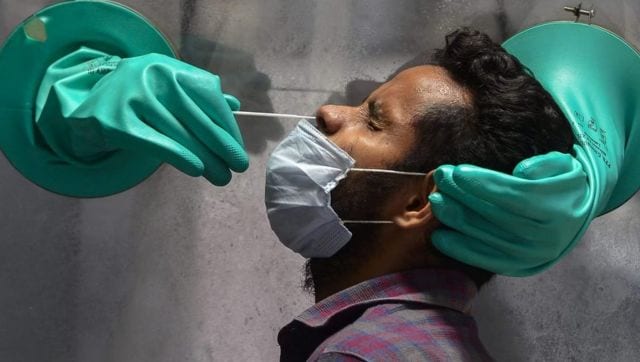COVID-19’s new strain ‘Pirola’ or BA.2.86 rapidly increasing: Should India be concerned?

A medic collects swab sample of a suspected Covid-19 patient for a test at a government hospital in New Delhi. Representational Image/ PTI.
The USA, UK and China have once again been witnessing rise in coronavirus cases. According to a new CDC risk assessment, a new COVID-19 strain BA.2.86, nicknamed Pirola, is making more people infected in several parts of the world.
A report by Hindustan Times quoted coronavirologist Dr Pavithra Venkatagopalan saying that Pirola variant seems to have as many changes as Omicron had from Delta variant of coronavirus.
Along with Pirola, Eris too have been infecting people are increasing the number of COVID-19 patients around the world. Both originate from the XBB lineage which descended from Omicron. These two variants are currently under the vigilant observation of the World Health Organization (WHO).
Related Articles

Is COVID-19 on the rise again with new variants Eris and BA.2.86?

UK reports first case of new Covid-19 variant, individual has no recent travel history
How dangerous in new COVID-19 Pirola variant?
Not many samples of the new strain Pirola or BA.2.86 have been received so far. Due to limited samples, the severity is not known.
As per reports just nine samples of BA.2.86 variant have been received, but this does not mean that there are just these many cases.
It suggests that of all the COVID-19 cases that were tested for the genome sequence, nine have been identified in different parts of the world.
However, as per the assessment by the CDC, “BA.2.86 may be more capable of causing infection in people who have previously had COVID-19 or who have received COVID-19 vaccines.”
This indicates that it may be more likely to cause breakthrough infections than previous strains of the virus.
Where have these 9 cases been reported from?
Of the total nine cases of Pirola, or BA.2.86, collected so far, three have been reported from Denmark, two each in South Africa and the US, one each in UK and Israel.
Where was COVID’s new strain BA.2.86 first identified?
A report by Health.com said that Pirola or BA.2.86 was first identified on 24 July, 2023. The WHO recently added this new variant to its list of “currently circulating variants under monitoring,” noting that the strain has a “large number of mutations identified.”
Why Pirola or BA.2.86 is variant of interest?
Though BA.2.86 is a subvariant of Omicron, “it has many, many more mutations than the mutations of each of the variants before,” Timothy Murphy, MD, senior associate dean for clinical and translational research at the University at Buffalo Jacobs School of Medicine and Biomedical Sciences, was quoted as saying by the Health.com.
Murphy further said, specifically, BA.2.86 has more than 35 amino acid changes to urs spike protein compared to the recently spreading XBB.1.5 on which the COVID-19 booster is based on.
As per CDC, the spoke protein mutations of BA.2.86 makes it likely to cause breakthrough infections.
“The virus uses the spike protein to bind the disease to cells. That’s what the vaccines are directed against,” Murphy said.
“With so many mutations in the spike protein, there is a greater chance that the vaccine and having previously been infected with COVID-19 won’t offer as much protection against BA.2.86 as prior strains of the virus,” the report by Health.com quoted William Schaffner, MD, an infectious disease specialist and professor at the Vanderbilt University School of Medicine, as saying.
Schaffner further said that initially, officials thought that BA.2.86 was not all that much different but, now that they have noted there are many mutations, they have raised the question about whether there may be some immune evasion on the part of this strain.
How does the new COVID variant transmits?
A report by ToI quoted Dr. Kuldeep Kumar Grover, Head of Critical care, CK Birla Hospital, Gurugram saying that both BA.2.86 and Eris share transmits through droplets.
Symptoms of BA.2.86 new COVID variant
Symptoms of BA.2.86 include rashes, conjunctivitis, and diarrhoea. Common symptoms associated with Eris infection include fever, cough, shortness of breath, fatigue, muscle aches, headache, loss of taste and smell, and sore throat.
Should India be worried?
The ToI report said the population’s past immunity from COVID vaccination may not provide full protection if BA.2.86 enters India because close to 17 or more mutations in the new subvariant are absolutely unfamiliar. However, active cases or new COVID cases in India do not indicate a surge.
Meanwhile, vaccine manufacturers have been updating their jabs as the virus is evolving. This, however, does not indicate that the previously administered vaccines are ineffective, but their efficacy might be somewhat less.
With inputs from agencies
For all the latest health News Click Here

